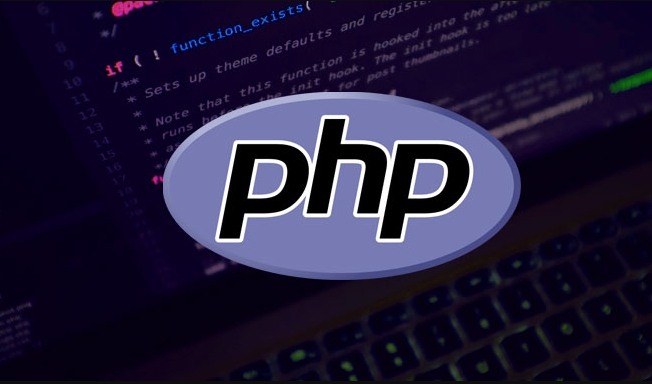The key to debugging PHP functions is to master practical methods and tools. 1. First check whether the input parameters are correct, use var_dump or print_r to print parameter values, and confirm whether the type, format and default values ??are reasonable; 2. Turn on error reports (error_reporting and display_errors), display all error messages, and help position variables undefined and keys, etc.; 3. Segmented test logic, and determine whether the code execution process and intermediate results are in line with expectations through temporary output or logging; 4. Use debugging tools such as Xdebug to cooperate with IDE to achieve breakpoint debugging, single-step execution, etc. to improve efficiency; 5. Maintain good code specifications to reduce debugging difficulties caused by confusing naming or unclear function responsibilities.

Debugging a PHP function is actually not difficult, the key is to master several practical methods and tools. When a function does not run as expected, we usually need to check input and output, process logic, error prompts and other aspects. Below are some commonly used debugging techniques in actual operations.

Check whether the input parameters of the function are correct
Many times the function errors because the parameters passed in are incorrect. For example, the type does not match, the value is empty, or the format is incorrect.

- You can print the passed parameters at the beginning of the function with
var_dump($param)orprint_r($param)to confirm whether they are the value you expect. - If it is an array or object,
print_r()is more suitable thanechobecause it can display the structure. - Note check whether the optional parameters have default values ??and whether they are accidentally overwritten.
For example:
function addNumbers($a, $b) {
var_dump($a, $b); // Check if it is a number return $a $b;
}Use error reports to locate problems
Sometimes PHP does not report an error directly, especially in production environments, where the error message may be closed.

- In the development environment, it is recommended to enable error reporting:
error_reporting(E_ALL); ini_set('display_errors', 1);
- This allows PHP to display all errors, including Notice and Warning, which helps quickly identify problems.
Common errors such as calling undefined variables, accessing non-existent array keys, spelling errors in function names, etc., will be exposed through these settings.
Segmented test function logic
If the function is long and contains multiple steps, you can comment out part of the code step by step, or insert temporary output statements to observe the execution process.
- For example, add an
echo 'Step 1 passed';to confirm whether a certain piece of code has been executed. - Or print out the intermediate results to see if they meet expectations.
- For complex judgment logic, logging (such as writing to files) can also be used instead of
echoto avoid damaging the page structure.
For example:
if ($condition) {
$result = doSomething();
file_put_contents('debug.log', "Result after doSomething: $result\n", FILE_APPEND);
}More efficient with debugging tools
If you often write PHP, it is recommended to be familiar with some debugging tools, which can greatly improve efficiency.
- Xdebug is the most commonly used PHP debugging extension. It can realize breakpoint debugging, single-step execution, viewing variables and other functions in conjunction with IDEs (such as PhpStorm, VS Code).
- If you don't want to install plug-ins, you can also use the online debugger or log analysis tool to assist in troubleshooting problems.
- Maintaining good code specifications during development can also help reduce debugging time, such as clear naming and single function responsibilities.
Basically these methods are all. Although it seems simple, many novices tend to ignore one or two of the details, resulting in low debugging efficiency.
The above is the detailed content of How to debug a PHP function?. For more information, please follow other related articles on the PHP Chinese website!

Hot AI Tools

Undress AI Tool
Undress images for free

Undresser.AI Undress
AI-powered app for creating realistic nude photos

AI Clothes Remover
Online AI tool for removing clothes from photos.

Clothoff.io
AI clothes remover

Video Face Swap
Swap faces in any video effortlessly with our completely free AI face swap tool!

Hot Article

Hot Tools

Notepad++7.3.1
Easy-to-use and free code editor

SublimeText3 Chinese version
Chinese version, very easy to use

Zend Studio 13.0.1
Powerful PHP integrated development environment

Dreamweaver CS6
Visual web development tools

SublimeText3 Mac version
God-level code editing software (SublimeText3)
 PHP Variable Scope Explained
Jul 17, 2025 am 04:16 AM
PHP Variable Scope Explained
Jul 17, 2025 am 04:16 AM
Common problems and solutions for PHP variable scope include: 1. The global variable cannot be accessed within the function, and it needs to be passed in using the global keyword or parameter; 2. The static variable is declared with static, and it is only initialized once and the value is maintained between multiple calls; 3. Hyperglobal variables such as $_GET and $_POST can be used directly in any scope, but you need to pay attention to safe filtering; 4. Anonymous functions need to introduce parent scope variables through the use keyword, and when modifying external variables, you need to pass a reference. Mastering these rules can help avoid errors and improve code stability.
 How to handle File Uploads securely in PHP?
Jul 08, 2025 am 02:37 AM
How to handle File Uploads securely in PHP?
Jul 08, 2025 am 02:37 AM
To safely handle PHP file uploads, you need to verify the source and type, control the file name and path, set server restrictions, and process media files twice. 1. Verify the upload source to prevent CSRF through token and detect the real MIME type through finfo_file using whitelist control; 2. Rename the file to a random string and determine the extension to store it in a non-Web directory according to the detection type; 3. PHP configuration limits the upload size and temporary directory Nginx/Apache prohibits access to the upload directory; 4. The GD library resaves the pictures to clear potential malicious data.
 Commenting Out Code in PHP
Jul 18, 2025 am 04:57 AM
Commenting Out Code in PHP
Jul 18, 2025 am 04:57 AM
There are three common methods for PHP comment code: 1. Use // or # to block one line of code, and it is recommended to use //; 2. Use /.../ to wrap code blocks with multiple lines, which cannot be nested but can be crossed; 3. Combination skills comments such as using /if(){}/ to control logic blocks, or to improve efficiency with editor shortcut keys, you should pay attention to closing symbols and avoid nesting when using them.
 How Do Generators Work in PHP?
Jul 11, 2025 am 03:12 AM
How Do Generators Work in PHP?
Jul 11, 2025 am 03:12 AM
AgeneratorinPHPisamemory-efficientwaytoiterateoverlargedatasetsbyyieldingvaluesoneatatimeinsteadofreturningthemallatonce.1.Generatorsusetheyieldkeywordtoproducevaluesondemand,reducingmemoryusage.2.Theyareusefulforhandlingbigloops,readinglargefiles,or
 Tips for Writing PHP Comments
Jul 18, 2025 am 04:51 AM
Tips for Writing PHP Comments
Jul 18, 2025 am 04:51 AM
The key to writing PHP comments is to clarify the purpose and specifications. Comments should explain "why" rather than "what was done", avoiding redundancy or too simplicity. 1. Use a unified format, such as docblock (/*/) for class and method descriptions to improve readability and tool compatibility; 2. Emphasize the reasons behind the logic, such as why JS jumps need to be output manually; 3. Add an overview description before complex code, describe the process in steps, and help understand the overall idea; 4. Use TODO and FIXME rationally to mark to-do items and problems to facilitate subsequent tracking and collaboration. Good annotations can reduce communication costs and improve code maintenance efficiency.
 Quick PHP Installation Tutorial
Jul 18, 2025 am 04:52 AM
Quick PHP Installation Tutorial
Jul 18, 2025 am 04:52 AM
ToinstallPHPquickly,useXAMPPonWindowsorHomebrewonmacOS.1.OnWindows,downloadandinstallXAMPP,selectcomponents,startApache,andplacefilesinhtdocs.2.Alternatively,manuallyinstallPHPfromphp.netandsetupaserverlikeApache.3.OnmacOS,installHomebrew,thenrun'bre
 How to access a character in a string by index in PHP
Jul 12, 2025 am 03:15 AM
How to access a character in a string by index in PHP
Jul 12, 2025 am 03:15 AM
In PHP, you can use square brackets or curly braces to obtain string specific index characters, but square brackets are recommended; the index starts from 0, and the access outside the range returns a null value and cannot be assigned a value; mb_substr is required to handle multi-byte characters. For example: $str="hello";echo$str[0]; output h; and Chinese characters such as mb_substr($str,1,1) need to obtain the correct result; in actual applications, the length of the string should be checked before looping, dynamic strings need to be verified for validity, and multilingual projects recommend using multi-byte security functions uniformly.
 Learning PHP: A Beginner's Guide
Jul 18, 2025 am 04:54 AM
Learning PHP: A Beginner's Guide
Jul 18, 2025 am 04:54 AM
TolearnPHPeffectively,startbysettingupalocalserverenvironmentusingtoolslikeXAMPPandacodeeditorlikeVSCode.1)InstallXAMPPforApache,MySQL,andPHP.2)Useacodeeditorforsyntaxsupport.3)TestyoursetupwithasimplePHPfile.Next,learnPHPbasicsincludingvariables,ech






